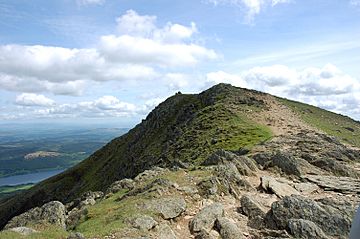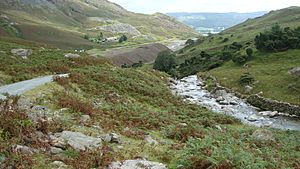Old Man of Coniston facts for kids
Quick facts for kids Old Man of Coniston |
|
|---|---|
 |
|
| Highest point | |
| Elevation | 802.42 m (2,632.6 ft) |
| Prominence | 416 m (1,365 ft) |
| Listing | Hewitt, Marilyn, Nuttall, Wainwright |
| Geography | |
| Location | Cumbria, England (traditionally Lancashire) |
| Parent range | Lake District, Southern Fells |
| OS grid | SD272978 |
| Topo map | OS Landranger 90, Explorer OL6 |
The Old Man of Coniston is a famous mountain, or "fell," located in the Lake District in Cumbria, England. It's a popular spot for tourists and hikers. For a long time, it was the highest point in the historic county of Lancashire. The mountain is about 802 meters (2,632 feet) tall. It sits west of the village of Coniston and the beautiful lake, Coniston Water. Sometimes people call it the Coniston Old Man or just The Old Man.
This mountain has a long history of mining for copper and slate. You can still see the remains of old mines and piles of rock from these activities on its slopes. Sheep also graze peacefully on the mountain.
Contents
How Tall is the Old Man?
The Old Man of Coniston stands at 802.42 meters (about 2,632 feet) high. This measurement was taken in 2018. The very top of the mountain has a man-made stone platform, which makes it slightly taller.
The Ordnance Survey maps, which are official maps of the UK, show The Old Man of Coniston as 803 meters tall. This makes it the highest point in the Furness Fells area. It's also one of the most important mountains in England based on how much it rises above the land around it.
What Does the Mountain Look Like?

The Coniston Fells are a range of mountains that separate Coniston Water to the east from the Duddon Valley to the west. This mountain range starts in the north at Wrynose Pass and stretches south for about 16 kilometers (10 miles).
The Old Man of Coniston is special because it stands out. It has steep sides on three different directions. This makes it look even taller and more impressive.
To the west of the mountain, there's a deep valley with a lake called Goat's Water. This long lake is about 15 meters (50 feet) deep and has fish like trout. Water from Goat's Water flows south into Torver Beck, which eventually reaches Coniston Water.
The southern and eastern parts of The Old Man have rough ground with many old slate quarries. One of these quarries, called Bursting Stone, still operates today. It produces a unique olive-green slate.
Across the southern slopes, you'll find the Walna Scar Road. This used to be an important trade route between Coniston village and the Duddon Valley. Today, it's a public path.
The first part of the road from Coniston is paved. It leads to a car park at about 225 meters (740 feet) high. This is a popular starting point for hikers. Beyond the car park, cars are not allowed, but the path continues up to about 610 meters (2,000 feet).
North of The Old Man, nestled between it and Raven's Tor, is another lake called Low Water. This lake was once dammed to provide water for the quarries. Now, its water flows down into the Coppermines Valley through beautiful waterfalls. This area, shared with nearby mountains like Brim Fell and Wetherlam, shows many signs of old copper mining from the 1800s.
The Summit Views
The very top of The Old Man has a special platform made of slate and a pile of stones called a cairn. Because so many people climb this mountain, the sheep living there are quite friendly! They might even try to find food in your unattended bags.
On a clear day, the view from the top is amazing. You can see much of the southern Lake District, Morecambe Bay, and even the Isle of Man far away. One of the best views is of Dow Crag, a nearby rocky peak.
How to Climb the Mountain
Most people start their climb from Coniston village. They follow paths that go past Church Beck and the old mines.
Other ways to climb include using the south ridge or the path to Goat's Water. Both of these routes start from the Walna Scar Road. The car park higher up on this road gives you a good head start. You can also reach the Walna Scar Road from Torver or from Seathwaite in the Duddon Valley, though these routes might be longer.
Mining History
The area around Coniston is famous for its copper and slate mines. The Coniston copper mines are thought to be some of the biggest in Britain. On the Old Man of Coniston itself, slate mining became very important. Over hundreds of years, the Old Man Slate Quarries & Mines grew to be some of the largest in England.
People believe that slate quarrying on The Old Man started as early as the 12th or 13th centuries. By the 1500s, the quarries were well-known for their silver-grey volcanic slate. Early major workings included Low Water Quarry, Scald Kop Quarry (which formed a large cave), and Saddlestone Quarry (which also had underground workings).
Geology of the Mountain
The rocks that make up The Old Man of Coniston are part of the Borrowdale Volcanic Group. These rocks were formed from ancient volcanoes during the Ordovician period. You can find different types of volcanic rock here, like dacitic tuffs and volcanic sandstones.
The Old Man in Stories
The Old Man of Coniston was the inspiration for a mountain called "Kanchenjunga" in Arthur Ransome's famous Swallows and Amazons books. In the novel Swallowdale, the characters climb this fictional mountain. The slate quarries and copper mines on The Old Man also inspired another book in the series, Pigeon Post.




